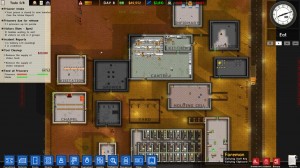On a recent podcast, I sat down with Forrest Dowling from Molasses Flood about the Flame in the Flood. The game is another title that has gone through the entire crowd-funding cycle of kickstarter to early access to release. On the cast I asked Forrest if he would like to make another game using Early Access, and he was the first developer I spoke to who said no.
Talking to him about it, he made some really good points and for today’s post, I’m effectively going to write the counterpoint to my own previous talk on the benefits of Early Access.
I suggest you read my previous post linked above, because it’s going to be framing the discussion for today. Early Access can be a great tool for developers, but besides the risks that we talked about, there are a few downsides for developers to consider.
1. Extra Work
Video game development is always a challenge no matter the size or expertise of the development team involved. Many developers can simply disappear to work on a game for months and not really spend time on anything else. With Early Access, it can be a lot of work along the lines of Kickstarter and setting up a project.
As with Kickstarter, despite working on a video game, you also have to pull double or even triple duty with managing the Early Access side of things. In the previous post I talked about having to keep both the game and your fans updated on what’s going on. People expect results and you cannot simply focus on your game 100% of the time.
It’s important these days to build your brand just as much as you are building your game; that means making posts, videos, releasing content on a regular basis. In other words, you cannot spend your whole time making a video game in order to succeed on Early Access. This is why developers tend to turn to someone to handle the PR side of things or have moderators on forums to keep track of them.

You need to approach Early Access differently than traditional game development; that means being more transparent with your audience and putting out progress regularly
If you’re someone who prefers to work in solitude and not have to worry about the press or fans until the game is done, Early Access is simply not for you.
Speaking about the game being done, the next problem has to do with the most important part of selling a game: Generating buzz.
2: Keeping the Momentum Going
In the past, the release of a brand new game when handled correctly was met by excitement.
Publishers who did their job right would have made sure that there were commercials available, reviews posted and that everyone knew when their games were coming out.
Today it’s a different story with games on Early Access. Because people are already playing the game, there is far less fanfare for the big 1.0 reveal.
Unless your game becomes as popular as Prison Architect or Darkest Dungeon, you probably won’t get a big front page announcement on Steam. Then there is the problem from the fan’s point of view and trying to keep them interested throughout the length of Early Access and beyond.
Going back to point one, there is a lot of work in creating a game on Early Access and failing to drive interest can kill your audience for it. This becomes even more of an issue for games looking to raise funding for years of Early Access development.
Klei Entertainment, who has had several Early Access successes has only put games on the platform that are pretty far along in terms of development; where the base systems are done and they are looking for that final 10 or 20% of fine-tuning, not a game with years of development left. You need to be able to continually put out marketing and announcements from beginning to end of the game’s cycle and beyond to keep the interest going.
Unless your game is a massive hit, you’re not going to be making enough to earn a profit while you are developing the game. Even with a successful Early Access period, it can still be tough to determine whether or not your game will continue to sell and hopefully earn a profit. The jump from Early Access to 1.0 is a big moment and it can be very difficult to properly make the change over.

Keeping people interested in your title through the development cycle and beyond requires constant development, planning and communication
For instance, with Invisible Inc and Darkest Dungeon, both games had their campaign modes finalized for the reveal; leaving something brand new for the release. Knowing what to reveal and hold back is another difficult point and it takes us to the final section for this post.
3. Not every game fits
Early Access has shown that it works for a variety of titles, but there are some that don’t really work for the platform; trying to pigeonhole them in can cause more harm than good. Games that are built around replayability either in single or multiplayer make great candidates for Early Access.
The main reason is that highly replayable games are those that the player can’t see everything there is and has to keep coming back for more. Prison Architect worked as it was not a linear game, but a set of systems that could easily be expanded upon in any number of ways.
Another point is that these games usually feature complex systems at work and can be tough to troubleshoot with a small testing pool. Using Early Access, you can have your fans play over every inch of your title and find problems that you may have never known about or would have caught after release; as I spoke with Tim Keenan from Misfits Attic about on a recent podcast.
With that said, games that are built around linear experiences or are narrative driven aren’t the best for Early Access. Because there is a limit on how much someone can play, you’re not going to have people play and replay your title to find bugs or other problems. What’s worse is that it’s almost impossible to keep the momentum going with player interest.
In a game like Prison Architect or Darkest Dungeon, every new piece of content enhances all the game systems and grows the experience; making sure that if someone comes back to the game, there will be something new to experience all around.
But when you’re working with a linear title, you’re not going to be crafting game changing content that’s going to impact the story and play you have set from the start. If somebody has already played through your 20 hour story, they’re not going to want to replay the whole thing for 20 minutes of new content. Trying to get years of development funding and Early Access support out of a linear title is not advised.
If you want to run a linear game through Early Access, it’s best to wait until the point where you need bug testing and pre release refinement. Early Access of this length should only be a month or two: Enough time to finalize the game and get last minute feedback before release.
One important note, if you’re making a game with both single and multiplayer content, you can get away with a longer Early Access period thanks to the multiplayer providing replayability (if the game is good of course.)
Taking the Good with the Bad:
At the end of the day, it’s going to be up to you as the designer to weigh the pros and cons about Early Access. From the people I’ve spoken with, most of the time Early Access is going to be the best option. The extra funding and eyes on your game can make all the difference in the world when it comes time to launch it. With that said, understanding what works and doesn’t work on the model will determine whether or not your game will succeed.



